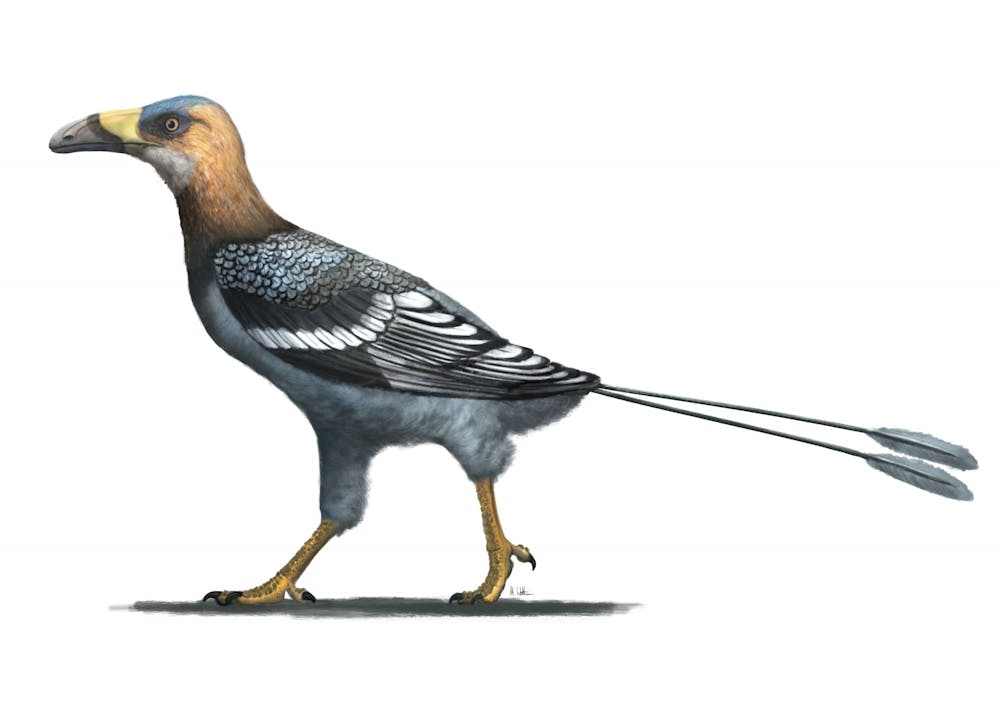Ten years ago in Madagascar, a few small fragments of a new specimen were uncovered in a muddy block of sandstone. The significance of these pieces was later discovered in 2017 after a micro-CT, or high-resolution digital imaging, scan found a new bird discovery: the Falcatakely.
This bird was discovered by an international team led by Patrick O’Connor, professor of anatomical sciences at Ohio University’s Heritage College of Osteopathic Medicine.This new specimen, living around 68 million years ago in the Mesozoic age, was the size of a large crow or small toucan, O’Connor said.
O’Connor said the partial skull that was found has an estimated length of about 9 centimeters, which can easily fit in the palm of a hand.
“Given that bird bones are infamously thin and lightweight, we had to use very delicate approaches to prepare and study the specimen,” he said in an email.
After the CT scan in 2017, the bird’s skull told scientists that this was unlike any other specimen they had discovered living at this time. The anatomy of the Falcatekely is unique due to the long, tall upper beak that is formed by a large maxillary bone, O’Connor said.
“When you see a beak in any modern bird, regardless of its size or shape, that beak is primarily made up by an enlarged premaxillary bone,” he said in an email. “So, to summarize, Falcatakely shows us an increased level of diversity in birds during the age of dinosaurs that was completely unknown until this discovery. It also shows us that there are multiple, different developmental pathways that can lead to beak enlargement.”
Fossilized birds during the Mesozoic Era are unique due to the lightweight construction of the skeleton. Scientists need to be aware and mindful in acknowledging that there is a lot that they do not know about birds during this time because of the disadvantages of limited fossils that remain, O’Connor said.
“We will no doubt continue to find more examples of birds and other animals with extremely specialized and/or unique features—it just takes more effort to find fossils in those hard-to-reach places,” he said in an email.
Because of the fragile nature of the bones, the Falatekely’s individual skull bones were unable to be removed from the rock. This team employed the use of a high-tech machine that is able to use extensive digital modeling to dissect the individual bones from the rock and 3D print them, according to an OU newsletter.
The international team that worked on this new scientific discovery found this skull on the final days of the field season in August 2010. When they found these bones originally, the team tentatively labeled it as a skull, Joseph Groenke, laboratory coordinator for OU HCOM and co-author of this study, said.
“Even when we had it back in the lab and we had carefully cleaned the surface under a microscope, it was not clear exactly what we had,” Groneke said in an email. “After a micro-CT scan at the Edison Biotechnology institute in 2017, though, we finally had enough evidence to declare with huge excitement that our original field identification had been correct.”
The international team on this project included a strong OU presence, including a former PhD student of Dr. O’Connor’s, who is currently part of the faculty at University College London. The other scientists who collaborated on this discovery spanned from the United States all the way to Madagascar, O’Connor said.
“We have the added bonus of getting to learn about different cultures, different languages, etc.,” O’Connor said in an email. “I think it makes the whole process that much more satisfying.”
OU had the microCT scans available in order to complete this study. OU also has a rapid prototyping, or 3D printing, machine without which the completion of this study would not have occurred, O’Connor said in an email.
“We discovered that with modern scanning technology and a lot of very careful work, we were able to digitally dissect a nearly completely flattened animal skull and to understand its anatomy in three dimensions,” Groenke said in an email. “This is a hopeful outcome, as many important fossils currently in museums around the world which are generally regarded as two dimensional might also reveal important new information using similar techniques.”






